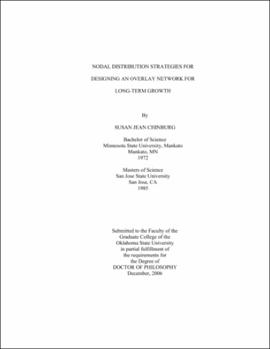| dc.contributor.advisor | Scheets, George | |
| dc.contributor.author | Chinburg, Susan Jean | |
| dc.date.accessioned | 2013-11-26T08:25:29Z | |
| dc.date.available | 2013-11-26T08:25:29Z | |
| dc.date.issued | 2006-12 | |
| dc.identifier.uri | https://hdl.handle.net/11244/6796 | |
| dc.description.abstract | Scope and Method of Study: | |
| dc.description.abstract | This research looked at nodal distribution design issues associated with building an overlay network on top of an existing legacy network with overlay network switches and links not necessarily matching the switch and link locations of the underlying network. A mathematical model with two basic components, switch costs and link costs, was developed for defining the total cost of a network overlay. The nature of the underlying legacy topology determines the dominant factor, link or switch costs to the total cost function as well as the unit cost for switches and links. | |
| dc.description.abstract | Findings and Conclusions: | |
| dc.description.abstract | The three design heuristics presented first, locate overlay switches at nodes in the center of the legacy network as opposed to the periphery; second, locate overlay switches at legacy nodes with high connectivity; and third, locate overlay switches at legacy nodes with high traffic flow demands, can be used to help point to the direction of keeping costs under control when design changes are required. Applying the concept of efficient frontiers to the world of network design and building a suite of best designs gives the network designer greater insight into how to design the best network in the face of changing real-world constraints. For the cost model and the case studies evaluated using the design strategies in this study, distributed approaches generally tend to be a good choice when the link costs dominate the total cost function because total path distances and therefore link costs need to be minimized in preference over switch costs. A distributed overlay tends to have lower link costs because there is usually a greater probability that total path distances can be minimized because of greater connectivity. More connections set up the potential for more traffic flow path choices allowing each traffic flow to be sent along shorter paths. In legacy network topology designs that have many nodes with high connectivity, the overlay link costs can be relatively similar between designs and the switch costs can have a large impact upon total cost. | |
| dc.format | application/pdf | |
| dc.language | en_US | |
| dc.rights | Copyright is held by the author who has granted the Oklahoma State University Library the non-exclusive right to share this material in its institutional repository. Contact Digital Library Services at lib-dls@okstate.edu or 405-744-9161 for the permission policy on the use, reproduction or distribution of this material. | |
| dc.title | Nodal distribution strategies for designing an overlay network for long-term growth | |
| dc.contributor.committeeMember | Weiser, Mark | |
| dc.contributor.committeeMember | Sharda, Ramesh | |
| dc.contributor.committeeMember | Wilson, Rick L. | |
| osu.filename | Chinburg_okstate_0664D_2142 | |
| osu.accesstype | Open Access | |
| dc.type.genre | Dissertation | |
| dc.type.material | Text | |
| dc.subject.keywords | network design | |
| dc.subject.keywords | overlay network design | |
| dc.subject.keywords | telecommunications | |
| dc.subject.keywords | network topology | |
| thesis.degree.discipline | Business Administration | |
| thesis.degree.grantor | Oklahoma State University | |
